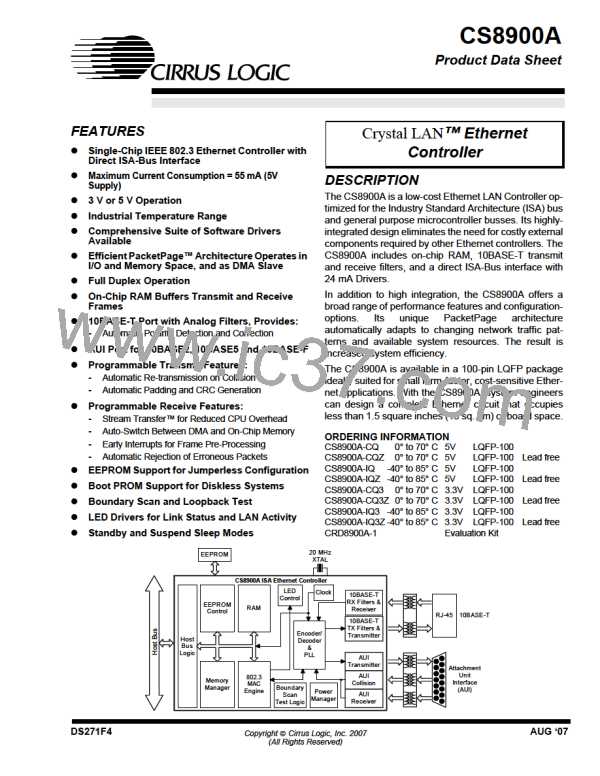CS8900A
Crystal LAN™ Ethernet Controller
4.7 Receive and Transmit Frame Locations CFG, bit BufferCRC). If CRC has not been se-
lected, then the length does not include the
CRC, and the CRC is not present in the re-
ceive buffer.
The Receive and Transmit Frame PacketPage
locations are used to transfer Ethernet frames
to and from the host. The host sequentially
writes to and reads from these locations, and
internal buffer memory is dynamically allocat-
ed between transmit and receive as needed.
One receive frame and one transmit frame are
accessible at a time.
After the RxLength has been read, the receive
frame can be read. When some portion of the
frame is read, the entire frame should be read
before reading the RxEvent register either di-
rectly or through the ISQ register. Reading the
RxEvent register signals to the CS8900A that
the host is finished with the current frame, and
wants to start processing the next frame. In
this case, the current frame will no longer be
accessible to the host. The current frame will
also become inaccessible if a Skip command
is issued, or if the entire frame has been read.
See Section 5.2 on page 78.
4.7.1 Receive PacketPage Locations
In IO mode, the receive status/length/frame lo-
cations are read through repetitive reads from
one IO port at the IO base address. See
Section 4.10 on page 75.
In memory mode, the receive sta-
tus/length/frame locations are read using
memory reads of a block of memory starting at
memory base address + 0400h. Typically the
memory locations are read sequentially using
repetitive Move instructions (REP MOVS).
See Section 4.9 on page 73.
4.7.2 Transmit Locations
The host can write frames into the CS8900A
buffer using Memory writes using REP MOVS
to the TxFrame location. See Section 5.6 on
page 99.
Random access is not needed. However, the
first 118 bytes of the receive frame can be ac-
cessed randomly if word reads, on even word
boundaries, are used. Beyond 118 bytes, the
memory reads must be sequential. Byte reads,
or reads on odd-word boundaries, can be per-
formed only in sequential read mode. See
Section 4.8 on page 72.
4.8 Eight and Sixteen Bit Transfers
A data transfer to or from the CS8900A can be
done in either I/O or Memory space, and can
be either 16 bits wide (word transfers) or 8 bits
wide (byte transfers). Because the CS8900A’s
internal architecture is based on a 16-bit data
bus, word transfers are the most efficient.
The RxStatus word reports the status of the
current received frame. RxEvent register 4
(PacketPage base + 0124h) has the same
contents as the RxStatus register, except Rx-
Event is cleared when RxEvent is read.
To transfer transmit frames to the CS8900A
and receive frames from the CS8900A, the
host may mix word and byte transfers, provid-
ed it follows three rules:
1) The primary method used to access
The RxLength (receive length) word is the
length, in bytes, of the data to be transferred to
the host across the ISA bus. The register de-
scribes the length from the start of Destination
Address to the end of CRC, assuming that
CRC has been selected (via Register 3 Rx-
CS8900A
memory is word access.
2) Word accesses to the CS8900A’s internal
memory are kept on even-byte boundaries.
3) When switching from byte accesses to
word accesses, a byte access to an even
CIRRUS LOGIC PRODUCT DATASHEET
72
DS271F4

 CIRRUS [ CIRRUS LOGIC ]
CIRRUS [ CIRRUS LOGIC ]